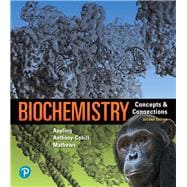For courses in biochemistry.
Engage students in biochemistry visually and through real-world applications
Biochemistry: Concepts and Connections engages students with a unique approach to visualization, synthesis of complex topics, and connections to the real world. The author team builds quantitative reasoning skills and provides students with a rich, chemical perspective on biological processes. The text emphasizes fundamental concepts and connections, showing how biochemistry relates to practical applications in medicine, agricultural sciences, environmental sciences, and forensics.
The newly revised 2nd Edition integrates even more robust biochemistry-specific content in Mastering™ Chemistry, creating an interactive experience for today’s students. New Threshold Concept Tutorials help students master the most challenging and critical ideas in biochemistry, while Interactive Case Studies connect course material to the real world by having students explore actual scientific data from primary literature. The 2nd Edition provides a seamlessly integrated learning experience via text, Mastering Chemistry, and an interactive Pearson eText.
Also available with Mastering Chemistry
Mastering™ is the teaching and learning platform that empowers you to reach every student. By combining trusted author content with digital tools developed to engage students and emulate the office-hour experience, Mastering personalizes learning and often improves results for each student.
Students can further master concepts after class through traditional and adaptive homework assignments that provide hints and answer-specific feedback. The Mastering gradebook records scores for all automatically graded assignments in one place, while diagnostic tools give instructors access to rich data to assess student understanding and misconceptions.
Note: You are purchasing a standalone product; Mastering Chemistry does not come packaged with this content. Students, if interested in purchasing this title with Mastering Chemistry , ask your instructor for the correct package ISBN and Course ID. Instructors, contact your Pearson representative for more information.
013480466X / 9780134804668 Biochemistry: Concepts and Connections Plus Mastering Chemistry with Pearson eText -- Access Card Package
Package consists of:
- 0134641620 / 9780134641621 Biochemistry: Concepts and Connections
- 013474716X / 9780134747163 Mastering Chemistry with Pearson eText -- ValuePack Access Card -- for Biochemistry: Concepts and Connections








